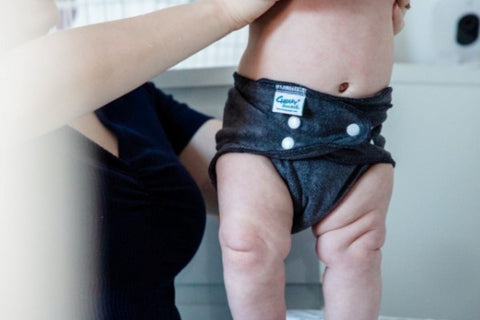
5 Must-Know Health Benefits of Reusable Nappies
Share
Over the last ten years, there has been a growing trend amongst parents and caregivers towards the use of reusable nappies, otherwise known as cloth nappies. The use of reusable nappies has become more popular due to their positive impact on the environment (unlike their single-use alternatives) but did you know there are also hidden health benefits for both babies and their caregivers? This article explores the different ways in which reusable nappies contribute to better health for parents and children when you make the switch.

1. Early Potty Training
Children in cloth nappies toilet train, on average, around six months earlier than their peers in disposables. This is because your child will tend to feel the wetness earlier because there are no absorbency gels, which helps a child make the connection between a full bladder and the release of muscles that help you go to the toilet. As a result, children using reusable nappies tend to transition to independent toilet use at an earlier age, which could also decrease the likelihood of urinary tract infections (UTIs) and constipation.
That being said, most reusable nappies will still have an outer cover of breathable, waterproof fabric, that helps keep your baby comfortable and dry for longer.
2. Monitor Stomach Health
One of the most significant advantages of using reusable nappies is that you will tend to notice any changes in the consistency and colour of your child’s poo when you empty and wash them, whereas with a disposable one — which you might otherwise wrap up and chuck in the bin as soon as possible — you might not. Although it can be a little difficult to get used to, this is a good way to keep track of the state of your child’s stomach, and how they are tolerating certain foods.

3. Less Nappy Rash
Research suggests that 1 in 3 babies are affected by nappy rash at any one point. Although it can happen at any age, nappy rash tends to have the most impact on children between 6 and 18 months old. The most tell-tale signs of nappy rash include:
- red or raw patches on your baby’s bottom.
- skin that looks sore and feels hot to touch.
- scaly and dry skin.
- spots, pimples, or blisters.
Reusable nappies tend to be made from more natural and breathable fabrics, and don’t use harsh chemicals, dyes, fragrances, chlorine or plastics that could otherwise irritate your child’s skin, reducing the chance of nappy rash.
You should keep in mind that cloth nappies can be less absorbent than disposable nappies so you are prompted to change these nappies more often, but this itself reduces the potential for nappy rash, which can be caused by prolonged contact between skin and urine or poo.
4. More Comfortable
A more comfortable baby is a happier one. Although disposable nappies keep the moisture away from the baby's bottom for longer, reusable nappies made from soft and natural fabrics (that are changed more often), will keep your baby comfortable for longer — and as we touched on earlier, reduce that risk of an uncomfortable nappy rash. After all, who would want to wear plastic pants all day?
Reusable nappies are also easier to fit. Depending on if you have a two-part, wrap or pull-up, most can be put on just like a disposable but, as they are often one-size, they will have hip to waist poppers that help you to achieve the perfect fit for your child.
5. Environmental Health
It goes without saying that climate change is not good for any of us, and certainly not for our children. As The World Health Organisation explains, climate change ‘affects the social and environmental determinants of health — such as clean air, safe drinking water, sufficient food and secure shelter — and is expected to cause approximately 250 000 additional deaths per year, from malnutrition, malaria, diarrhoea and heat stress.’
While switching to reusable nappies won’t immediately fix these concerns, it will help to reduce plastic pollution — which can ‘alter habitats and natural processes, reducing ecosystems' ability to adapt to climate change’ — and contribute to the wider environmental movement away from harmful disposables to sustainable alternatives that is essential for protecting our planet.

